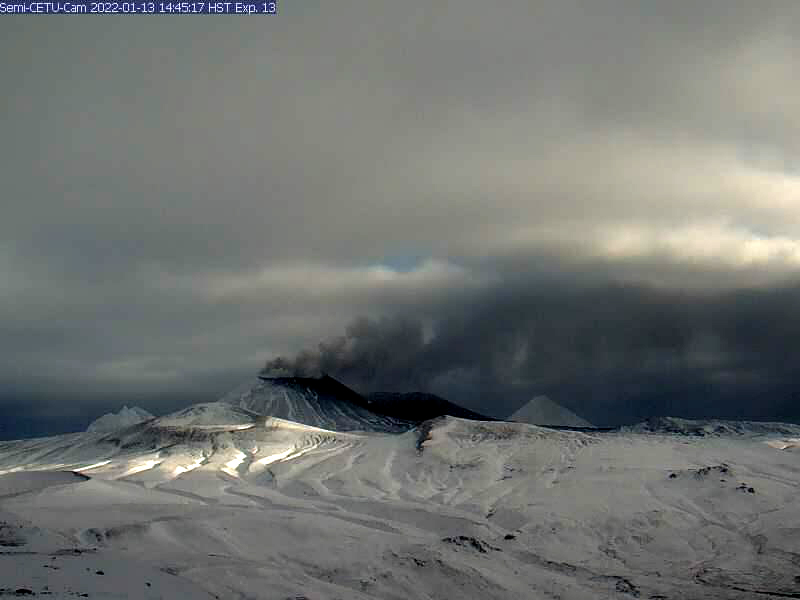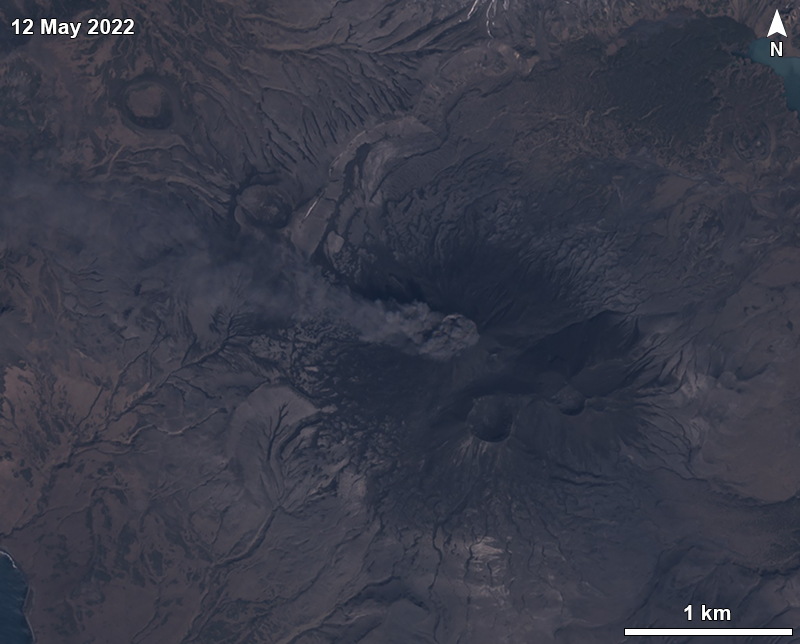Report on Semisopochnoi (United States) — June 2022
Bulletin of the Global Volcanism Network, vol. 47, no. 6 (June 2022)
Managing Editor: Edward Venzke.
Research and preparation by Paul Berger.
Semisopochnoi (United States) Numerous weak ash explosions during December 2021-May 2022
Please cite this report as:
Global Volcanism Program, 2022. Report on Semisopochnoi (United States) (Venzke, E., ed.). Bulletin of the Global Volcanism Network, 47:6. Smithsonian Institution. https://doi.org/10.5479/si.GVP.BGVN202206-311060
Semisopochnoi
United States
51.93°N, 179.58°E; summit elev. 1221 m
All times are local (unless otherwise noted)
Recent low-level unrest at Semisopochnoi, the largest of the western Aleutian Islands, has been confined to the North Cerberus crater, one of three summit craters (see figure 5 in BGVN 46:06). Activity has consisted of intermittent weak explosions and generally weak emissions, along with plumes of ash, gas-and-steam, and sulfur dioxide (BGVN 45:04 and 46:12). This report describes activity during December 2021-May 2022, using weekly updates from the Alaska Volcano Observatory (AVO) and satellite data. AVO monitors the volcano by webcam, infrasound sensors, satellite images, a seismic network, and lightning detections.
According to AVO, low-level eruptive activity continued during the entire reporting period. Seismicity also remained elevated, mostly consisting of periods with small intermittent seismic tremor. During this time, the Aviation Color Code remained at Orange and the Volcano Alert Level remained at Watch, the second highest level for both. Weather clouds usually prevented satellite and webcam views.
Multiple ash explosions occurred daily during the first three weeks of December 2021. Minor ash emissions and plumes rose to an altitude of less than 3 km, and often less than 1.5 km (300 m above the summit), drifting about 100 km E on 3-4 December. 185 km SE on 8-9 December, and 100 km NE on 31 December. According to AVO reports, the number of weekly explosions diminished to “occasional” during the last week of December through the first three weeks of January, although ash plumes could still be observed (figure 21).
 |
Figure 21. Webcam image of an ash emission from the N crater of Semisopochnoi’s Mount Cerberus at 1445 on 13 January 2022. Courtesy of AVO/USGS. |
During late January through early May 2022 the number of weekly explosions were variously described as daily, almost daily, or occasional. Multiple daily explosions were recorded during the last three weeks of May (figure 22). Ash explosions often had to be inferred from visible low-level ash clouds, because weather clouds obscured ground observations on most days. According to AVO reports, steam plumes drifted as far as 70 km SW during 6-7 April, and to distances of more than 100 km at altitudes below 1.5 km during 7-8 April. An ash plume drifted up to 80 km WNW on 8 April.
AVO reports indicated the presence of sulfur dioxide plumes on 21 March and the latter part of May 2022. A sulfur dioxide plume drifted 240 km N during 17-18 May, and sulfur dioxide emissions were detected during 23-24 and 27-29 May. NASA’s TROPOMI instrument aboard the Sentinel-5P satellite recorded high sulfur dioxide levels only on 9 April and 29 May, both highly localized above the volcano.
Elevated surface temperatures were identified in satellite images in the N crater of Mount Cerberus during 15-17 and 19-20 December 2021, and 28-29 May 2022. The MIROVA system recorded only two hotspots during the reporting period, in late January and mid-May 2022, both of very low radiative power. No thermal alerts were recorded by the MODVOLC algorithm for MODIS thermal anomalies.
Geological Summary. Semisopochnoi, the largest subaerial volcano of the western Aleutians, is 20 km wide at sea level and contains an 8-km-wide caldera. It formed as a result of collapse of a low-angle, dominantly basaltic volcano following the eruption of a large volume of dacitic pumice. The high point of the island is Anvil Peak, a double-peaked late-Pleistocene cone that forms much of the island's northern part. The three-peaked Mount Cerberus (renamed Mount Young in 2023) was constructed within the caldera during the Holocene. Each of the peaks contains a summit crater; lava flows on the N flank appear younger than those on the south side. Other post-caldera volcanoes include the symmetrical Sugarloaf Peak SSE of the caldera and Lakeshore Cone, a small cinder cone at the edge of Fenner Lake in the NE part of the caldera. Most documented eruptions have originated from Young, although Coats (1950) considered that both Sugarloaf and Lakeshore Cone could have been recently active.
Information Contacts: Alaska Volcano Observatory (AVO), a cooperative program of a) U.S. Geological Survey, 4200 University Drive, Anchorage, AK 99508-4667 USA (URL: https://avo.alaska.edu/), b) Geophysical Institute, University of Alaska, PO Box 757320, Fairbanks, AK 99775-7320, USA, and c) Alaska Division of Geological & Geophysical Surveys, 794 University Ave., Suite 200, Fairbanks, AK 99709, USA (URL: http://dggs.alaska.gov/); Sentinel Hub Playground (URL: https://www.sentinel-hub.com/explore/sentinel-playground); Global Sulfur Dioxide Monitoring Page, Atmospheric Chemistry and Dynamics Laboratory, NASA Goddard Space Flight Center (NASA/GSFC), 8800 Greenbelt Road, Goddard, Maryland, USA (URL: https://so2.gsfc.nasa.gov/); MIROVA (Middle InfraRed Observation of Volcanic Activity), a collaborative project between the Universities of Turin and Florence (Italy) supported by the Centre for Volcanic Risk of the Italian Civil Protection Department (URL: http://www.mirovaweb.it/); Hawai'i Institute of Geophysics and Planetology (HIGP) - MODVOLC Thermal Alerts System, School of Ocean and Earth Science and Technology (SOEST), Univ. of Hawai'i, 2525 Correa Road, Honolulu, HI 96822, USA (URL: http://modis.higp.hawaii.edu/).


